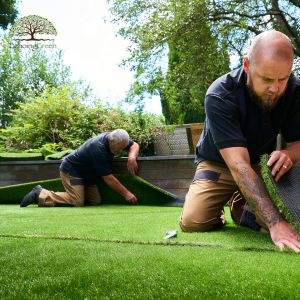23 Apr 2025
Why Your Base Matters When Installing Artificial Grass for Backyards
The first step to installing artificial grass for backyards is selecting the right turf that fits your home, family, and lifestyle. There are a number of grasses on the market, but not all of them are made equal. High-quality artificial grass from leading Canadian suppliers and installers, like Echoing Green, is made for performance. Available in a wide variety, homeowners can choose the perfect artificial grass based on the fullness, volume, durability, application, and style you prefer. Once you’ve picked your perfect match, the next step is to set up the base for your artificial grass installation. This step is crucial, as it will determine how well your artificial grass application will perform over the years. A strong, well-prepared base ensures that your artificial lawn remains smooth, stable, and comfortable for decades. For support with the installation of your artificial grass for backyards, contact the experts at Echoing Green for meticulous, high-quality, durable workmanship.
To learn more about why the base for your artificial grass matters, read on.
The Role of the Base in Turf Installation
 A proper base for your artificial grass does more than support the turf itself. The base creates a level, resilient surface that handles foot traffic, pets, and weather without shifting or becoming uneven. The base is the first line of defence against problems like pooling water, poor drainage, and sink areas. It also affects how soft or firm your lawn feels underfoot. For homeowners considering synthetic turf installation, investing time and effort in the base preparation ensures that the finished result is not just attractive but also durable and low-maintenance.
A proper base for your artificial grass does more than support the turf itself. The base creates a level, resilient surface that handles foot traffic, pets, and weather without shifting or becoming uneven. The base is the first line of defence against problems like pooling water, poor drainage, and sink areas. It also affects how soft or firm your lawn feels underfoot. For homeowners considering synthetic turf installation, investing time and effort in the base preparation ensures that the finished result is not just attractive but also durable and low-maintenance.
When you choose artificial grass for your lawn or backyard, you can be confident that the turf can be installed over virtually any surface, from soil to concrete and more.
Here’s why perfecting your base is key.
Levelling the Application Area
Levelling the installation area is the foundation for a successful project. A flat, even surface prevents future issues like bumps, uneven wear, or water collection. Without proper levelling, the final installation can appear distorted or feel unstable underfoot. This step also promotes consistency across the entire surface and prepares the area for the next base layer.
For artificial grass installation, a level subgrade forms the baseline for structural integrity. It allows each layer, gravel, fines, and turf, to sit properly and perform as intended.
Gravel and Aggregate
The gravel and aggregate layer is essential to the strength and longevity of the artificial lawn. A well-compacted layer of crushed stone gives the artificial grass installation a solid, non-shifting foundation. Because the gravel or aggregate layer also serves as a buffer between the ground and the grass, it can help reduce soil movement, stabilizing the entire surface and supporting a uniform pressure distribution. This minimizes the risk of future sinking or surface distortion caused by foot traffic, weather, or use over time.
Weed Barrier
The weed barrier supports one of the most alluring benefits of artificial grass backyards. The high-density fibre barrier placed below the surface of the artificial grass helps prevent unwanted vegetation or growth from interfering with your artificial lawn, rendering it virtually weed-free and preserving the clean look and appearance of your artificial lawn.
Optimize Your Artificial Grass Installation with Echoing Green
A solid, well-constructed base can make all the difference in your artificial grass installation. To learn more about getting the most out of your backyard artificial grass application, book a free site visit with Echoing Green.

